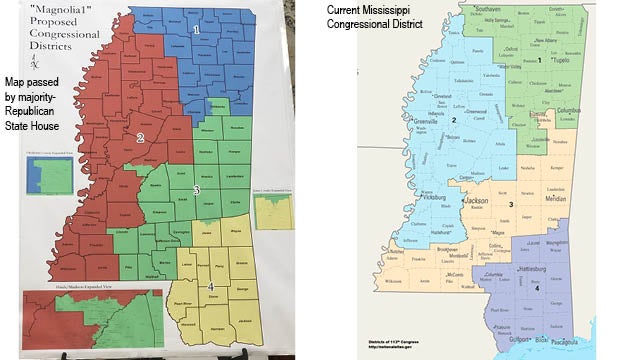Mississippi governor signs bill for congressional remap
Published 11:55 am Monday, January 24, 2022

- At left, the redistricting map approved by Gov. Tate Reeves on Monday. At right, Mississippi's current Congressional Districts.
|
Getting your Trinity Audio player ready...
|
JACKSON (AP) — Mississippi Gov. Tate Reeves on Monday signed a bill that redraws the boundaries of the state’s four congressional districts—moving Adams, Franklin, Wilkinson and Amite counties into the 2nd District from the 3rd to account for changes in population.
Reeves, a Republican, said weeks ago that agrees with the plan in House Bill 384, which was passed by the Republican-controlled state House and Senate.
The NAACP or other opponents could still ask a federal court to consider whether the new districts dilute the influence of Black voters.
The plan expands the territory of the state’s only majority-Black U.S. House district because the 2020 census showed the 2nd District lost population during the previous decade.
However, Democratic Rep. Bennie Thompson opposed the plan.
Thompson is Mississippi’s longest-serving current member of Congress, having held the 2nd District seat since wining a 1993 special election. The district stretches through the Delta and into the city of Jackson.
Thompson said he wanted to expand the district but still keep it relatively compact by taking in more of the densely populated Jackson metro area. That proposal is also favored by the state NAACP. Instead, the plan gives the 2nd District about 40% of the state’s landmass by moving four sparsely populated southwestern counties — Franklin, Adams, Wilkinson and Amite — into the 2nd District from the 3rd.
The 3rd District stretches diagonally across the central part of the state. The seat is held by Republican Rep. Michael Guest, first elected in 2018.
Republican Rep. Trent Kelly has held the 1st District seat in northern Mississippi since winning a 2015 special election. Republican Rep. Steven Palazzo was first elected to the 4th District seat in the south in 2010.
Legislators said the goal is for each of the four congressional districts to have about 740,020 residents.
Officials are supposed to draw districts that are compact and contiguous and that maintain communities of interest. Contiguous means the districts contain areas that are connected — and, ideally, the districts are not in odd shapes.
Candidates face a March 1 qualifying deadline to run for the four U.S. House seats.





